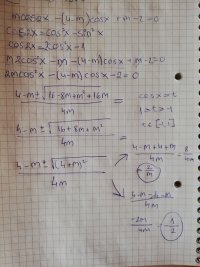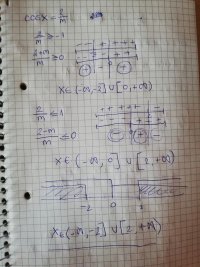You are using an out of date browser. It may not display this or other websites correctly.
You should upgrade or use an alternative browser.
You should upgrade or use an alternative browser.
Calculate x, don't understand
- Thread starter Loki123
- Start date
topsquark
Senior Member
- Joined
- Aug 27, 2012
- Messages
- 2,269
The cosine function has a period of [imath]2 \pi[/imath]. So to get the complete solution we need to add an integer multiple (it could be negative) of [imath]2 \pi [/imath] to the answer. If you were solving for tangent you would add an integer multiple of just [imath]\pi[/imath] because that's the period of tangent.I needed to calculate x. I got x1, x2 correctly. However the answer (the correct answer) includes more information which I don't understand. It is written in the last picture. Can someone explain it to me? View attachment 32881View attachment 32882View attachment 32883
-Dan
Dr.Peterson
Elite Member
- Joined
- Nov 12, 2017
- Messages
- 16,092
What don't you understand about this?I needed to calculate x. I got x1, x2 correctly. However the answer (the correct answer) includes more information which I don't understand. It is written in the last picture. Can someone explain it to me?
At the start of the work, you need to observe that if m=0, then the equation is not quadratic, so the quadratic formula does not apply. The equation then is just -4 cos(x) - 2 = 0.
As Dr. Peterson said, when m = zero, the [imath]\cos(2x)[/imath] term drops out. Mathematically, that is all that needs to be said.
Implicitly, however, we solve this equation using a substitution, namely [imath]\lambda = \cos(x)[/imath]. When m [imath]\ne[/imath] 0, the equation AFTER SUBSTITUTION is quadratic, but is linear if m = 0. The underlying equation, however, is trigonometric whether or not m is zero. As a matter of language, the explanation is confusing because, if you go back to the original equation and let m = 0, you get
[math]- 4\cos(x) - 2 = 0[/math],
an equation that is blatantly not linear. Therefore, the explanation only makes sense if you remember the substitution that was IMPLICIT.
My impression is that, in the teaching of math, there is a lot of implicit substitution that causes confusion for students. In distinction to what your book says, notice how carefully Dr. Peterson talks about “using the quadratic formula.” He never says the equation is linear. He says that if m = 0, the equation is not quadratic, which is certainly true and which is sufficient to justify the fact that the quadratic formula does not apply.
Implicitly, however, we solve this equation using a substitution, namely [imath]\lambda = \cos(x)[/imath]. When m [imath]\ne[/imath] 0, the equation AFTER SUBSTITUTION is quadratic, but is linear if m = 0. The underlying equation, however, is trigonometric whether or not m is zero. As a matter of language, the explanation is confusing because, if you go back to the original equation and let m = 0, you get
[math]- 4\cos(x) - 2 = 0[/math],
an equation that is blatantly not linear. Therefore, the explanation only makes sense if you remember the substitution that was IMPLICIT.
My impression is that, in the teaching of math, there is a lot of implicit substitution that causes confusion for students. In distinction to what your book says, notice how carefully Dr. Peterson talks about “using the quadratic formula.” He never says the equation is linear. He says that if m = 0, the equation is not quadratic, which is certainly true and which is sufficient to justify the fact that the quadratic formula does not apply.
Dr.Peterson
Elite Member
- Joined
- Nov 12, 2017
- Messages
- 16,092
Ironically, I almost did call it linear! I wasn't making the distinction you have in mind. But you're right about the implicit substitution. For nonzero m, the equation is quadratic in cos(x). For m=0, it is linear in cos(x). And these are important things to be able to see.My impression is that, in the teaching of math, there is a lot of implicit substitution that causes confusion for students. In distinction to what your book says, notice how carefully Dr. Peterson talks about “using the quadratic formula.” He never says the equation is linear. He says that if m = 0, the equation is not quadratic, which is certainly true and which is sufficient to justify the fact that the quadratic formula does not apply.
A common way for textbooks to handle this is to call an equation "quadratic in form", meaning that after a substitution it will be actually quadratic; and they are presumably trying to get students to see the form by making that implicit substitution (whether or not they ever literally make a substitution -- as Loki stated the substitution but didn't actually write the resulting equation).
Since we aren't shown the book's entire solution, it is also possible that they make this statement not about the original equation, but about the equation in t, after the substitution.




